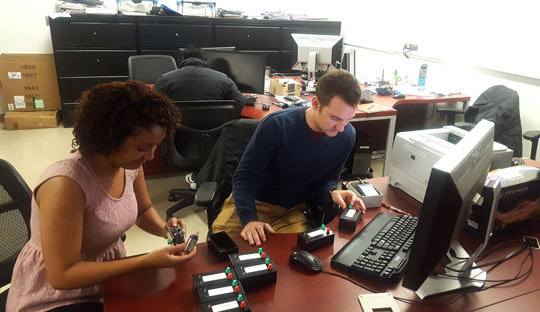Seventeen University of Toledo students will present their projects at the 31st Annual National Conference on Undergraduate Research at the University of Memphis Thursday through Saturday, April 6-8.
These projects by UT students were chosen from more than 4,000 submissions.

Blen Keneni, left, and Branden Austin worked on finalizing their system prototype for their research on “Frequency Spectrum Sharing and Priority Assignment in Communication Systems.” They will present their work this week at the 31st Annual National Conference of Undergraduate Research in Memphis, Tenn.
Branden Austin and Blen Keneni, students in the Electrical Engineering and Computer Science Department in the College of Engineering, will present “Frequency Spectrum Sharing and Priority Assignment in Communication Systems” at the conference.
With a National Science Foundation Research Experiences for Undergraduates grant, the two worked last summer and fall on a project with Dr. Vijaya Kumar Devabhaktuni, professor of electrical engineering, as their adviser.
The purpose of their project was to build an educational prototype for attracting high school seniors and college students to pursue university degrees.
“The prototype entails demonstrable hardware and software comprised of a set of communication nodes with call priorities, which are used to help educate students on future and practical implications of spectrum sharing,” Devabhaktuni said.
“Two objectives are achieved by building this hands-on prototype: Students learn firsthand the basics of communication systems, and they are taught the concept and feasibility of ‘priority’ in radio frequency device communication.”
Devabhaktuni said this research experience provided the students with techniques beneficial in their future endeavors: hardware and software design, collaborative research skills, and time and project management.
Keneni is pursuing a master’s degree in electrical engineering; she graduated with a bachelor of science degree in electrical engineering in December. She was a senior while working on this research project. Austin is a senior undergraduate dual major in electrical and computer science engineering.
“What I liked about this research is the freedom it gave me to be creative while it challenged my engineering skills,” Keneni said. “It gave me the opportunity to have a detailed understanding of topics related to communication, radio frequency devices, as well as hardware and software design.”
Keneni added, “This undergraduate research can be used to teach students about communication systems, and it will be a great project to present during job interviews.”
“The best part of the research for me is getting to work on challenging projects that make a difference,” Austin said. “It was great to work on a project applicable to teaching students about current and emerging technology. I gained valuable contacts in both academia and industry through research.
“This, and being selected to present our research at a national conference, opens up doors for both grad school and future employment,” he said.
Other UT students who will present their work at the National Conference on Undergraduate Research, the titles of their abstracts, and faculty advisers are:
• Quinton Babcock, “Lake Erie Water Quality Survey, A Natural Treatment Option to Reduce Harmful Algal Blooms,” Dr. Kevin Egan, associate professor of economics;
• Sanskar Basnet, “Beam-Foil Measurement of the Lifetime of Ge II 4s2 4d 2D3/2 Level,” Dr. Richard Irving, research assistant professor in the Department of Physics and Astronomy;
• Jason Gonring, “Feasibility Study: Solar-Powered Electric Fencing and Hydration for the Buffalo Girls Project,” Dr. Barbara Mann, professor in the Honors College, and Richard Molyet, associate professor of electrical engineering;
• Emily Grubbs, “Women’s Involvement in the Inside Out Prison Exchange Program,” Dr. Jerry Van Hoy, associate professor of sociology;
• Wonhee Kim and Keeyong Hong, “Collaboration Art Beyond Culture,” Daniel Thobias, assistant professor of art;
• Jay Kumar, “The Effect of Nicotine on Ovarian Cancer Cells,” Dr. Deborah Chadee, associate professor of biological sciences;
• Dalal Mahmoud, “Impact of Microcystin on Pre-Exisiting Liver Disease,” Dr. David Kennedy, assistant professor of medicine;
• Batool Mehdi, “Regulation of MLK3 in Ovarian Cancer Cells,” Chadee;
• Zehra Mehdi, “The Role Maternal Reminiscing Style Plays in the Accuracy of Child Reports,” Dr. Kamala London Newton, associate professor of psychology, and Monica Lawson, graduate student in experimental and developmental psychology;
• Megan Post, “Study of Furoxans in a Murine Model of Ischemic Stroke,” Dr. Isaac Schiefer, assistant professor of medicinal and biological chemistry;
• Taylor Robbins, “Comparing the Articulatory Kinematics and Acoustic Vowel Space Between Healthy and Apraxic Speakers,” Dr. Caroline Menezes, associate professor of speech-language pathology;
• Michaela Roberts, “Centriole Remodeling and Poc1 Enrichment in Drosophila Melanogaster,” Dr. Tomer Avidor-Reiss, associate professor of biological sciences;
• Olivia Sagan, “Regulation of MLK Kinases in Ovarian Cancer Cells,” Chadee;
• Shannon Saluga, “Photoredox Catalysts and Their Applications in Organic Synthesis,” Dr. Wei Li, assistant professor of chemistry;
• Nadeen Sarsour, “Prenatal Androgen Exposure in Adult Female Wistar Rats,” Jennifer W. Hill, associate professor of physiology and pharmacology; and
• Raj Thomas, “Investigating the Role of MLK3 in Mitotic Progression of Ovarian Cancer Cells,” Chadee.